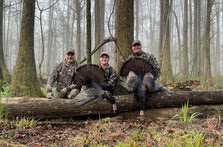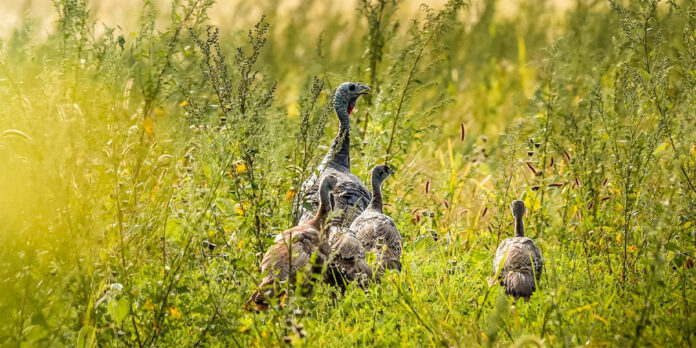MONTGOMERY — Despite not being able to use decoys for the first 10 days of the season, Alabama turkey hunters continue to take far more birds during the first week of the season than any other week.
“Opening day is opening day, no matter if it’s March 25 or April 25,” said Chuck Sykes, the Alabama Department of Conservation and Natural Resources’ (ADCNR) Wildlife and Freshwater Fisheries (WFF) director. “Our Game Check data from the past five seasons shows that we kill more turkeys during opening week than any other week. If that opening day had been April 1, it would have been the exact same thing.
“Timing is closer to prime breeding season. They typically aren’t in winter flocks, and you can get a gobbler to come to a call better.”

Sykes said his hunt in Elmore County on opening day this year followed his premise that the breeding season is fully underway. He accompanied two brothers on their family farm, continuing a 10-year tradition.
“This year, the fog was so thick that if I hadn’t been hunting with them, I would have gone back to bed,” he said. “Turkeys in most places wouldn’t have said a word, but they have a really good place. We got there way before daylight, and a turkey gobbled. We eased across a little slough and set up. By that time, two or three turkeys were gobbling. I waited until I thought they were on the ground before I called the first time. I yelped and three turkeys answered me.
“About 15 minutes later, I see two heads coming through the woods. I’m 30 yards behind the boys.”
The turkeys got within range of the brothers and one shot, rolling one of the gobblers. But that wasn’t the end of the story.
“The other turkey jumped up, so I started cutting,” Sykes said. “He’s running around in circles, trying to figure out what’s going on. I’m calling, and he starts gobbling. Then another turkey starts gobbling. The other brother crawls toward his brother to try to get a shot, but he can’t. Then all of a sudden, the brother that shot jumps up and starts running. He runs out of sight.
“I asked if his turkey got up. He said, ‘Yep, got up and ran off.’ We’re standing there talking, and there’s a turkey gobbling in front of us. We waited about five minutes, and I yelped. The turkey gobbled about 100 yards from us. I ran back to my spot, and he got set down. By the time I got set down, he gobbled and was about 60 yards away. I look and there’s three coming straight to me. They got about 30 yards from the other brother, and he got one of them. In the meantime, the other brother had caught his turkey.
“He said he was sitting there, and all of a sudden, he sees a head pop up, and the turkey started flouncing down through the woods. He didn’t have to chase the bird too far, so we ended up with two birds.”
Although more turkeys are reported on Game Check on opening week than any other time of the season, it doesn’t mean the birds won’t cooperate later in the season. The zone seasons are:
- Zone 1, which covers the majority of the state, is March 25 through May 8 with decoys allowed starting April 4.
- Zone II in the northwest part of the state, the season is April 1 through May 8 with decoys allowed starting April 11.
- Zone III (Clarke, Clay, Covington, Monroe, Randolph and Talladega counties) is the only zone with a fall season, which runs Nov. 16-24 and Dec. 14-29 with no decoys allowed during the fall. The Zone III spring season is March 25 through May 8 with decoys allowed starting April 4.
The yearly bag limit for all zones is four gobblers per person. Visit www.outdooralabama.com/
“I’ve had two of the best hunts of the year on the last day of the season the last two years,” Sykes said. “They’re still doing their thing, but it all depends on the pressure on the property.”
For those who are new to the turkey hunting endeavor, which can be intensely addictive, Sykes said it starts with doing your homework by scouting the area you plan to hunt and looking for tracks and scratching.
“Until you get proficient with a call, the less calling you do the better,” he said. “Stick with plain yelps and clucks every once in a while. There have been a lot of turkeys killed back in the old days when they would cluck three times and set the call down. Then cluck three times in another hour. The setup kills more turkeys than anything. If you’re not in the right place, the best caller in the world is not going to do any good.”
Sykes also said waiting on the perfect weather to head to the turkey woods is a mistake. You have to be present to win.
“Rain or shine, hot or cold, the turkeys aren’t going anywhere,” he said. “They’re used to it being 100 degrees in August and 20 degrees in January. Guess what? They’re still going to do what turkeys do. If it’s hot or rainy, they may not gobble as much. If you do your homework, you can still kill turkeys when it hot, and you can still kill turkeys when it’s cold.”
Sykes said Alabama turkey hunters are known to be hardcore, but he hopes some will think about more than just bagging a bird.
“According to our data, very few people are killing four turkeys a season,” he said. “Very few people are killing three turkeys. Most people kill one or two. But we also have people who don’t quit once they’ve killed their fourth turkey. Until that attitude changes, no seasons or bag limits will change that. We can’t out-regulate that. Until people start putting bird first and not their feelings, turkeys will stay in trouble. It goes back to personal ethics and how you were brought up. I’m not saying I’ve always been a saint, but I understand now that it’s way more important to take care of the resource instead of taking care of my needs.”
During his 12-year tenure as WFF director, Sykes has witnessed a troubling decline in the ability for turkey hens to rear enough poults to sustain the population. The data from the 2024 season did, however, offer a ray of hope.
“The bottom line is we had our best hatch last year that we’ve had in more than a decade,” he said. “It’s still nothing to jump up and down about, but typically you want more than two poults per hen to survive if you want a growing population. Last year, in our statewide survey (Avid Turkey Hunter and WFF staff), we had two poults per hen survive. That’s the highest in 12 years. That’s not great, but at least it’s stable.
“One year out of 12 doesn’t mean we have a stable population. It means we had a good hatch last year.”
Sykes said he and his wife decided to undergo intensive management on their property in west Alabama to see if the turkey population would rebound.
“We had a great hatch on our place last year for the first time in as far back as I can remember,” he said. “The reason that happened is we made a conscious effort four years ago to not kill a turkey on our place. In addition to no hunting, we thinned a bunch of timber and did a lot of burning. That’s why we had a good hatch.”
Don’t miss out! Subscribe to our email newsletter to have all our smart stories delivered to your inbox.



